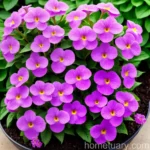Primrose (Primula ‘Alejandra’): A Comprehensive Guide
Introduction
Primrose (Primula ‘Alejandra’) is a remarkable plant that captivates enthusiasts with its vibrant blooms, unique characteristics, and versatility. In this comprehensive guide, we will explore the various aspects of this fascinating plant, from its cultural requirements to its uses, and from its propagation techniques to common diseases and pests. Whether you are an experienced gardener or a novice plant enthusiast, this guide will provide valuable insights into the care and maintenance of Primula ‘Alejandra’.
What is Primrose (Primula ‘Alejandra’)?
Primula ‘Alejandra’ is a hybrid primrose that belongs to the Primula genus, which comprises over 500 species of low-growing, herbaceous plants. These charming perennials are known for their bright and cheerful flowers that appear in early spring, adding a burst of color to gardens and landscapes. The ‘Alejandra’ variety is particularly prized for its vibrant blooms and robust growth habits, making it a popular choice for both indoor and outdoor gardening.
Key Takeaways
Before delving into the specifics of Primula ‘Alejandra’, let’s summarise the key takeaways that we will explore in detail throughout this guide:
- Culture
- Uses
- Water
- Sunlight
- Fertilizer
- Soil
- Pruning
- Propagation
- Container Popularity
- Container Common Diseases
- Disease Diagnosis
- Common Pests
- Botanist’s Tips
- Fun Facts
- Links to External Resources
Now, let’s dive into each of these aspects to gain a comprehensive understanding of Primula ‘Alejandra’ and how to care for it effectively.
Culture
Water
Proper watering is crucial for the health and vitality of Primula ‘Alejandra’. These plants prefer consistently moist soil, especially during their active growing season. However, it is essential to avoid over-watering, as waterlogged soil can lead to root rot and other issues.
Tips for Watering:
- Water the plants regularly, ensuring that the soil remains evenly moist but not waterlogged.
- Use a well-draining potting mix to promote adequate moisture retention while preventing water accumulation.
- Monitor the soil moisture regularly, especially during warm and dry periods, to adjust the watering frequency as needed.
Sunlight
When it comes to sunlight requirements, Primula ‘Alejandra’ thrives in partial shade to full shade conditions. While they can tolerate some morning sun, they prefer sheltered spots with dappled light or indirect sunlight, especially in regions with hot summers.
Tips for Sunlight:
- Place the plants in locations where they receive filtered sunlight or shade, such as under tall trees or on the north side of buildings.
- Avoid exposing Primula ‘Alejandra’ to intense, direct sunlight, as this can scorch the leaves and flowers.
- In indoor settings, position the plants near east or west-facing windows to provide them with the ideal amount of light.
Fertilizer
Proper fertilization is essential for promoting healthy growth and abundant blooms in Primula ‘Alejandra’. A balanced, water-soluble fertilizer designed for flowering plants can be applied during the active growing season to provide the necessary nutrients.
Tips for Fertilizing:
- Use a fertilizer with a balanced NPK ratio, such as 10-10-10 or 20-20-20, to support overall plant health and flowering.
- Apply the fertilizer according to the manufacturer’s instructions, typically every 2-4 weeks during the growing season.
- Avoid over-fertilization, as excessive nutrients can lead to leaf burn and other growth abnormalities.
Soil
Primula ‘Alejandra’ thrives in well-draining, humus-rich soil that provides ample moisture retention while preventing waterlogging. A slightly acidic to neutral pH range is ideal for these plants, ensuring optimal nutrient uptake and root health.
Tips for Soil Preparation:
- Use a high-quality potting mix that is formulated for acid-loving plants, or create a custom blend by combining peat moss, compost, and perlite.
- Ensure the soil is well-draining to prevent water accumulation, especially in container gardening situations.
- Test the soil pH periodically and adjust it if necessary to maintain the optimal growing conditions for Primula ‘Alejandra’.
Uses
Ornamental Features
The vibrant blooms of Primula ‘Alejandra’ make it a beloved choice for ornamental gardening, adding splashes of color to landscapes, borders, and containers. Whether grown as individual specimens or clustered with other spring-blooming plants, these primroses create stunning visual displays.
Indoor and Outdoor Gardening
Primula ‘Alejandra’ is well-suited for both indoor and outdoor gardening, providing opportunities to brighten up interior spaces and enhance outdoor landscapes. Their adaptability to partial shade conditions makes them versatile options for various settings, from shaded garden beds to indoor planters.
Container Gardening
The compact size and colorful blooms of Primula ‘Alejandra’ make it an excellent candidate for container gardening. Whether grown in pots, hanging baskets, or window boxes, these primroses bring a touch of elegance to patios, balconies, and other urban spaces.
Pruning
Proper pruning helps maintain the health and appearance of Primula ‘Alejandra’, ensuring compact growth and abundant flowering. Regular deadheading of spent blooms and removal of yellowing or damaged foliage can promote continuous blooming and prevent the spread of diseases.
Tips for Pruning:
- Remove faded flowers promptly to encourage the development of new blooms and prevent the plant from expending energy on seed production.
- Trim back any discolored or withered leaves to maintain the plant’s appearance and prevent the spread of diseases.
- Prune the plants in early spring to promote a compact growth habit and stimulate vigorous growth for the upcoming blooming season.
Propagation
Primula ‘Alejandra’ can be propagated through several methods, including division, seed sowing, and leaf or root cuttings. Each technique offers unique advantages and challenges, allowing gardeners to propagate new plants and expand their primrose collection.
Propagation Methods:
- Division: Divide established clumps of Primula ‘Alejandra’ in early spring or after the blooming season, separating the rhizomes or offsets and replanting them in suitable growing locations.
- Seed Sowing: Collect mature seeds from the plants and sow them in a moist, well-draining growing medium, providing the necessary warmth and humidity for successful germination.
- Leaf or Root Cuttings: Take leaf or root cuttings from healthy plants and propagate them in a controlled environment, ensuring proper moisture levels and indirect light for root development.
Container Popularity
Primula ‘Alejandra’ has gained popularity as a container plant due to its compact growth habit, striking blooms, and adaptability to shaded conditions. Whether displayed as standalone specimens or combined with other shade-loving plants, these primroses add an elegant touch to container gardens.
Common Diseases
Disease Diagnosis
Primula ‘Alejandra’ is susceptible to certain fungal and bacterial diseases, as well as environmental stressors that can compromise its health. Common issues include powdery mildew, root rot, and leaf spot diseases, which can impact the plant’s vitality and flowering performance.
Symptoms of Common Diseases:
- Powdery Mildew: White, powdery fungal growth on the leaves and stems, leading to distorted growth and reduced vigor.
- Root Rot: Yellowing, wilting, or mushy roots, accompanied by stunted growth and overall decline in plant health.
- Leaf Spot Diseases: Dark, water-soaked lesions on the foliage, often with yellowing or browning of affected areas.
Botanist’s Tips
To mitigate the risk of diseases in Primula ‘Alejandra’ and ensure optimal plant health, consider the following tips from botanists and plant health experts:
- Provide Adequate Air Circulation: Ensure proper spacing between plants and promote good air circulation to reduce humidity and minimize the risk of fungal diseases.
- Avoid Overhead Watering: Water the plants at the base to prevent moisture accumulation on the foliage, which can contribute to the development of diseases.
- Monitor and Act Promptly: Regularly inspect the plants for signs of diseases or stress, and take proactive measures to address any issues before they escalate.
Common Pests
Primula ‘Alejandra’ can fall prey to various pests, including aphids, slugs, and snails, which may feed on the foliage, flowers, or tender shoots. Vigilant monitoring and proactive pest management can help prevent infestations and minimize damage to the plants.
Common Pests:
- Aphids: Small, soft-bodied insects that may cluster on the undersides of leaves and excrete sticky honeydew, leading to sooty mold growth.
- Slugs and Snails: Nocturnal pests that feed on the foliage and flowers, leaving behind ragged edges and irregular holes in the leaves.
Pest Management Strategies
- Manual Removal: Handpick aphids, slugs, and snails from the plants, especially during the early morning or evening when they are most active.
- Natural Predators: Encourage beneficial insects, such as ladybugs and lacewings, or use biological controls to manage aphid populations and reduce pest damage.
- Barriers and Traps: Place physical barriers or traps, such as copper tape or beer traps, to deter slugs and snails from reaching the plants and causing damage.
Fun Facts
- Primula is derived from the Latin word “primus,” meaning first, as these early-blooming plants are among the first to flower in the spring.
- Primula ‘Alejandra’ is known for its vibrant blooms in a range of colors, including shades of pink, purple, and white, adding a delightful burst of color to the garden.
Links to External Resources
For further information on caring for Primula ‘Alejandra’ and exploring its various aspects, consider accessing the following resources:
- Royal Horticultural Society – Primula Cultivation
- American Primrose Society – Growing Primroses
- University of Illinois Extension – Primula Diseases
In conclusion, Primula ‘Alejandra’ stands as a captivating plant with a wealth of ornamental and cultural significance. From its exquisite blooms and versatile uses to its specific cultural requirements and potential challenges, this hybrid primrose offers a fascinating subject for plant enthusiasts and gardeners alike. By understanding its needs and implementing best practices, individuals can cultivate and enjoy the beauty of Primula ‘Alejandra’ in various gardening settings.
Whether grown in containers on urban balconies, shaded garden beds, or indoor planters, these resilient primroses reward their caretakers with an abundance of colorful blooms and a touch of natural elegance.
Remember to adapt the care techniques and recommendations based on your local climate and environmental conditions, as well as considering any specific guidance provided by local gardening experts or horticultural societies.
As you embark on your journey with Primula ‘Alejandra’, may the vibrant blooms and unique characteristics of this hybrid primrose inspire and delight you as you nurture these charming plants in your gardening adventures.















